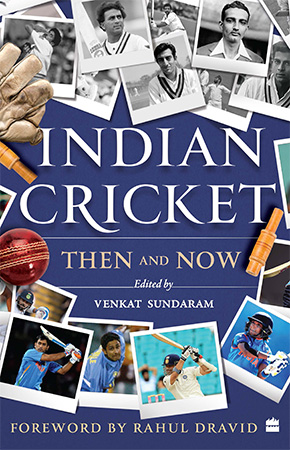This splendid book Indian Cricket - Then and Now has been split into six self-explanatory parts - The Early Years, Legends of the Past, Winds of Change, The Modern Age, Domestic Stalwarts and Beyond the Pavilion. Each section is well-populated and representative of the anthology's eventual purpose, to chronicle the story of India's cricketing journey.
In the foreword, Rahul Dravid, one of India's greatest batsmen, has remarked: "I have always held cricket writers in high esteem. They do an excellent job of documenting local, domestic and international cricket and deserve the highest accolades for their contributions.
One of the reasons for cricket assuming such spectacular character is the development of the infrastructure. We are second to none and some of India's stadiums can match the best in the world. Each era has its attraction and stories that capture the exploits of our players. It has been a privilege to be a part of this fabulous cricket journey and I am glad that we can now read the defining stories of Indian cricket in the form of a book."
Commencing with the very first Test match that India played in 1932, Indian Cricket chronicles a remarkable journey, highlighting key moments in the country's cricketing history over the last century or so: from the incredible Test triumphs in the 1970s and the thrilling World Cup victories of 1983 and 2011 to the emergence of the Indian Premier League, the evolution of women's cricket, the development of world-class ground facilities and the appearance of the 'superfit' Indian cricketer. Alongside, it celebrates some true cricketing legends: from C.K. Nayudu, Vijay Hazare, Vijay Merchant, Nari Contractor, Tiger Pataudi, Ajit Wadekar, Salim Durani and the spin quartet to Sunil Gavaskar, Gundappa Viswanath, Kapil Dev, Dilip Vengsarkar, Anil Kumble, Sachin Tendulkar, Mahendra Singh Dhoni and Virat Kohli.
Yajurvindra Singh, a former Test cricketer, says we all admire Mahendra Singh Dhoni's captaincy in the modern era, but in his time, Pataudi was a shrewd captain, who led India to its first overseas Test series win. In fact, he was brought back to play for the country in 1975 only for his captaincy. Apart from his batting, Pataudi was also good in the field and was considered to be one of the best fielders of his time. He made the Indian team believe that they could win. It was under his captaincy that the spin-bowling quartet of Bishan Singh Bedi, Erapalli Prasanna, Bhagwat Chandrasekhar and Srinivas Venkataraghavan, and the batting maestro Gundappa Viswanath, all blossomed.
Narottam Puri, in his article on Commenting on Cricket, believes that the TV coverage in India, during the past twenty-five years, has greatly improved and now features commentators from all over the world, usually legendary former players. Broadcasters use twenty to thirty cameras and advanced acoustics and technology. It would be safe to say that the phenomenal popularity of the game in India owed, and continues to owe, a tremendous debt to radio and television broadcasts.
In a chapter on Virat Kohli: The Hero of New-age cricket, Vijay Lokapally believes one Kohli knock that won't be forgotten was in the game against Pakistan in the 2022 T20 World Cup in Australia. On Diwali eve at a packed Melbourne Cricket Ground, Kohli produced one of the greatest knocks in the history of the game. In a high-pressure match against India's arch-rivals, he single-handedly powered his team to victory from a hopeless situation. Fans knew that the Kohli we had long celebrated was back. This was the born-again Virat Kohli, setting new benchmarks.
Thoughtfully constructed and pleasing, the book is presented with care and attention to detail consistent with this publisher's high standards. A thoroughly worthwhile and readable book. All who browse through this book will be impressed by the wide range of reading displayed by the Editor. There is a remarkable wealth of interesting information throughout.
|

